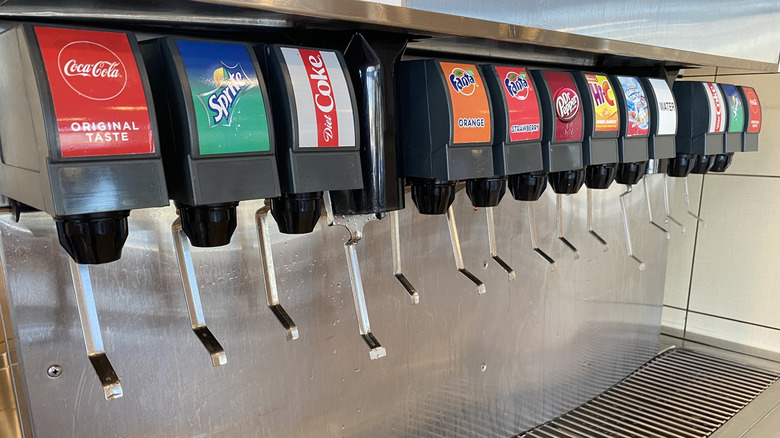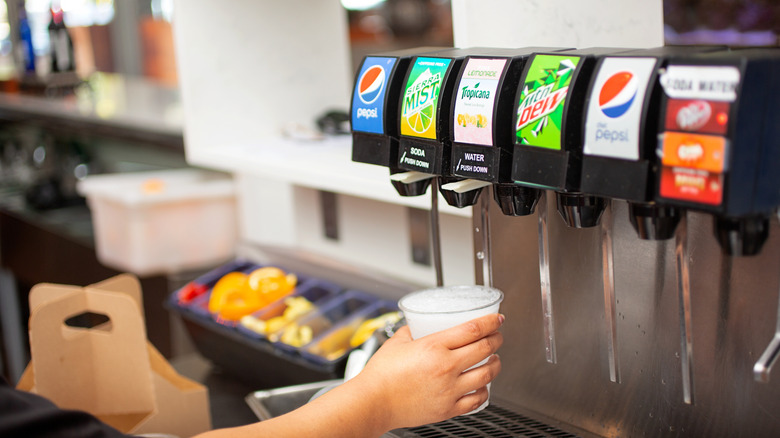Restaurant Soda Fountains Are Dirtier Than You Think
Readers be warned: If you ardently love fountain drinks from restaurants, you should probably stop reading right now, because ignorance is bliss when it comes to these potentially bacteria-ridden machines. Now, soda (or pop if you're from the Midwest) from fountains often have a distinctly different taste that many people enjoy. In fact, many people agree that Sprite tastes better when it comes from McDonald's, for instance, and it's not something you can replicate in the can. Unfortunately, while fountain sodas can be refreshing, there's a darker side to them.
In 2010, researchers from the Virginia Western Community College Department of Biology released a study regarding microorganisms and bacteria found in soda fountains. Out of 90 drinks from 20 self-serve fountains, they found coliform bacteria, a potential indicator of fecal contamination, in 48% of samples, E. Coli in 11%, and Chryseobacterium meningosepticum in 17%. Others detected included Candida, Stenotrophomonas, and Staphylococcus bacteria, many of which were demonstrated to be resistant to at least one of the 11 antibiotics tested on them. Even more striking was that the researchers found that these bacteria weren't linked to machine disinfection practices, meaning bacteria were likely to survive even with regular cleaning.
More recently, researchers from Loma Linda University discovered microbial contamination in water sampled from soda fountains in Southern California. One reason for this contamination was biofilms like slime, which can develop in water filtration systems found in soda fountains. Although the samples were confined to Southern California, the researchers surmised that the problem is most likely widespread and often overlooked.
Why are soda fountains such a hotbed for bacteria?
The reason why soda fountains are so dirty is similar to why soft-serve ice cream machines are a food safety nightmare. Typically, soda machines are supposed to be regularly cleaned, with basic sanitizing done daily and a complete deep clean done monthly. If a restaurant keeps up with cleaning, its fountains should be safe to drink from, but unfortunately, this doesn't always happen, and the nozzles, hoses, water filtration system, and ice machine are all perfect places for bacteria, slime, and mold to grow.
Moreover, bacteria can easily be transferred to the machine by folks simply using it. Even if the fountain isn't self-serve at a restaurant, employees not washing their hands or coming to work sick before using the machine could transmit bacteria. Bacteria can also be transmitted through the main water line, where the damp conditions allow colonies to thrive. Likewise, without regular cleaning, things like sugar snakes can build up inside syrup lines. These long gelatinous masses are made up of solidified sugar and bacteria that feed off it, and they can eventually grow to clog the entire line. If that wasn't enough, insects will often flock to these machines because of the sugary syrup, bringing with them a host of nasty bacteria.
So, is there any way to tell whether or not you should trust a restaurant's soda fountain? Honestly, no. At a glance, it's impossible to see the conditions inside the machine, but if the place is severely understaffed or has cleanliness issues elsewhere, you're probably best steering clear. That said, most fountains are perfectly fine to drink from, but it's still worth knowing about the nasty dangers that some can hide.

